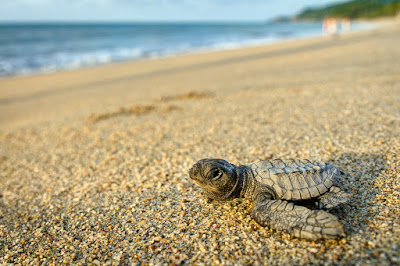Sometime back, I visited Chilika Lagoon
of Odhisha, India, as part of the National Nature Camping Programme organized
by Government of India. Although I went to educate kids and teachers, I cannot
stop myself from exploring nature. Staying in the middle of a flourishing scrub
jungle, how could I live without smelling the scenic scent of Chilika Lagoon?
Ruchikulya, one of the mass nesting site
of the Olive Ridley sea turtle species, was just a few kilometers away from our
tent. I was glad of my companion, Hussain, who is a wildlife researcher.
I was very excited about the nesting
habit of Olive Ridley sea turtle, hearing about its complete details from
Hussain, and was eagerly waiting to experience it. All the kids and teachers
were asleep after a tiresome trekking session on the first day of our camp, so
we decided to leave the camp, leaving it in the care of the janitor.
We walked our way towards the Ruchikulya
beach passing through Poornabandha village. It was a most terrifying walk that
I ever experienced till date, yet memorable indeed. Spotted owlets and peafowls
howling, crickets screeching, dogs barking, cats fighting; we even heard some
unusual noises of some animals and birds. We switched off our torches and
walked along the tiniest foot path along the bushes. Reaching the spot, we saw
a small tent near the shore which Hussain said is for the turtle
conservationist to take a nap. Alas, for us; the conservationist-in-making
occupied it for the night.
 |
| Olive Ridley Sea Turtle Hatchling |
We waited for two hours for the turtles
but nothing turned up. I dozed off as a cool sea breeze swayed the tent. After
a while, my friend woke me up in excitement to see the miraculous sight. I saw
around four Olive Ridley sea turtles flapping their way towards the shore, so
they could dig in the sand to lay their eggs.
As we were astonished by this sight, my
friend had another spectacular scene: little Olive Ridley hatchlings coming out
from under the sand, crawling and pushing their way out. Within minutes, a
bunch of hatchlings followed. It was
beyond belief for us witnessing both the adult and the hatchlings on the same
night.
In the meantime, we could see many stray
dogs roaming around the beach in search of food. Maybe they knew that these
hatchlings would come out any time and were hunting for them. Before these
beautiful hatchlings became their food, we thought that something should be
done in order to save these tiny beautiful creatures. We found a gunny sack in
the tent, which Hussain said is used to relocate eggs to save them from these
predator dogs.
Why we can’t use this sack to collect
hatchlings now, I thought. I immediately suggested my idea to Hussain for which
he said he was also thinking of the same thing. We acted immediately and
carefully collected every hatchling coming out from the sand and put them
inside the sack. We even dug the sand to see how many were left behind. After
half an hour of intense search, we were left with a sack full of beautiful
hatchlings. We did not count them as we were in a hurry.
We then went near the sea water and left
every hatchling there with utmost care. Hussain said that the hatchlings should
walk through sand to find the water; hence we left them on the sand a few feet
before water. We were also very keen on the stray dogs, watching the process.
After a while, every hatchling found the water and swam through safely.
We felt extremely happy and satisfied.
It was such a lovely sight, and I still cannot forget each and every thing that
happened on that eve. The most amazing and beautiful part of all is that the
hatchlings after attaining adulthood will come back to this same place where
they were born to lay their eggs.
Night of the Hatchlings
 Reviewed by Gowthama Rajavelu
on
14:18
Rating:
Reviewed by Gowthama Rajavelu
on
14:18
Rating:
 Reviewed by Gowthama Rajavelu
on
14:18
Rating:
Reviewed by Gowthama Rajavelu
on
14:18
Rating:









No comments: